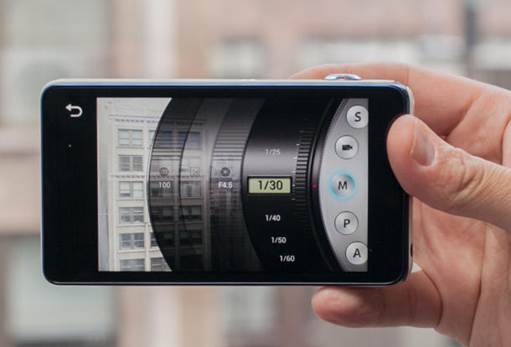Software
Let’s get back to the first question: Why
you have to bother whether there is Android on a camera? When it operates
properly, like what Samsung has done before, the answer for that question is
what you feel right after switching the device on. Instead of the traditionally
bulky screen, you are welcome by specific modifiable environment. Favorite
photos can be used as the background; slideshow applications can cycle through
your recent shots with friends; sharing applications and photo editor that you
regularly use can be placed at the mean positions; the default keyboard can
even be changed into another one if you want, making it easier for you to tag,
rename and add captions to those you wish to upload.

Why
you have to bother whether there is Android on a camera?
The overall effect is that you might feel
more creative and connected to the photography, to the point as what Samsung
advertised about a “new visual communication era”. It is so hard to explain,
but it is strange and interesting to watch everybody’s Instagram pictures on a
powerfully equipped device for photographing without any other hardware or file
transfer interference.
It will be very great to use zoom in
Instagram application, especially when Samsung stated that the application was
changed to allow this, there is still no sign of such feature. Twiddling the
zoom now is just modifying the volume of the device, like what happening
everywhere except Samsung’s camera applications.

Image
after edited by Galaxy Camera
There is also no “Camera mode”. For taking
pictures, you just need to launch the camera applications, whose icon lies on
the lower-left corner of the main screen. You can also press the shutter
release to reach the same result. Either way takes less than 2 seconds for the
lens protector to flip open, the barrel to appear and the camera to focus and
take pictures. The shooting interface itself is very simple and organized, but
concentrating on photographing based on scene and auto.
On the left side of the screen, which
displays the current mode, are the main controllers, a dial for choosing
another mode, as well as on-screen button for recording videos and shutter
button (behaving the same as the physical button but sometimes more
convenient). The auto mode is quite good, but we recognized that sometimes it
misjudged the color balance and tended towards overexposure. Any uncomfortable
feeling with the Auto’s results will lead to the second mode, which is also
easy to use, called Smart. It combines no less than 15 specific shot styles – not
only scene-based profiles (for example: Macro, Silhouette, Landscape), but also
shot modes (Continuous Shot, Best Shot, HDR/Rich Tone), and connectivity
options (Panorama, Best face), and effects (like Beauty face, which claims to
fluid any imperfections). It sounds strange, but it quickly turns out to be
very logical when organizing everything this way, and more importantly, each
Smart mode is really effective at helping you getting your desirable results.
Finally, if you are still not satisfied
with what Smart can do, you will need to use the least visual mode among three
modes: Expert, which might freeze the screen with many onscreen dials including
P/S/A/M, ISO, exposure compensation, aperture and shutter speed. Depending on
your priority options, one or many of these dials become gray and cannot be
accessed, because it is under the control of the camera. In the full Manual
mode, the exposure compensation dial cannot be accessed and used to display the
level in which show whether you are over or under exposing, according to the
camera’s estimations. In general, it is a rational system which is still loyal
to the way the camera works, and it seems to be very essential for creativity
control, but compared to physical dials, it is still very hard to reach the
level of good manual devices or to react to quickly modifying conditions as the
photo viewing is hid because of every dials, and there are too much tapping.

The
manual mode
About the photo reviewing, the built-in gallery
apps are nothing different from those on the newest smartphone and tablets of
Samsung, but it is worth being on this device. When you are looking at a photo,
there are just four main buttons that might be related to that photo, lying along
the top right of the screen and they are well considered. The Share button
brings a list of built-in apps that can be used to share or exploit the photos
for instance, if you have the Evernote app installed on the camera, this button
will give you an option to create a comment on the viewing photo. The second
button is a shortcut for the sharing solution that you used last – therefore,
if you use Facebook as the main sharing channel, the second button would be
Facebook logo. The third one is Delete button, while the forth is used to
display an extended menu including almost every other things that you might
want to do with your photos: including the basic crop, rotate and rename
functions, and opening the photo in one out of two built-in editing app to
operate other complex editions (you have the smart and easy-to-use Photo
Wizard, or Paper Artist which is mainly comprised of gimmicky effects). Of
course, you can use any of these apps to edit photos as long as you prefer –
the entire Android ecosystem is under your control.
It is now obvious that the software of this
device is not only worth a bonus – it is the highlight feature of Galaxy
Camera, and so appealing that it might be difficult to be back to the
traditional cameras. However, hopefully, everything will not stop there: right
now, when Samsung signals to be willing to allow third party developers to
design applications specifically for this camera module, we can imagine many
ways that can make this camera more suitable for many classes of users from the
technology bloggers to realtors, location scouts or any other unknown people
who will want automated scripts for resizing, watermarking and sharing photos;
remote applications; and who knows what else will it be. Of course, it’ll just
happen if the popularity of this camera reaches its peak. According to what we
observe now, there are many serious drawbacks in this device to be specific,
the image quality and battery life which Samsung is of course able to enhance.